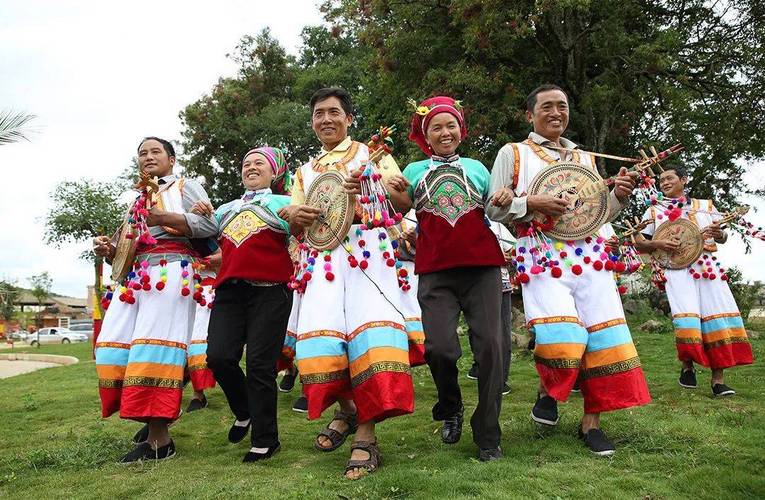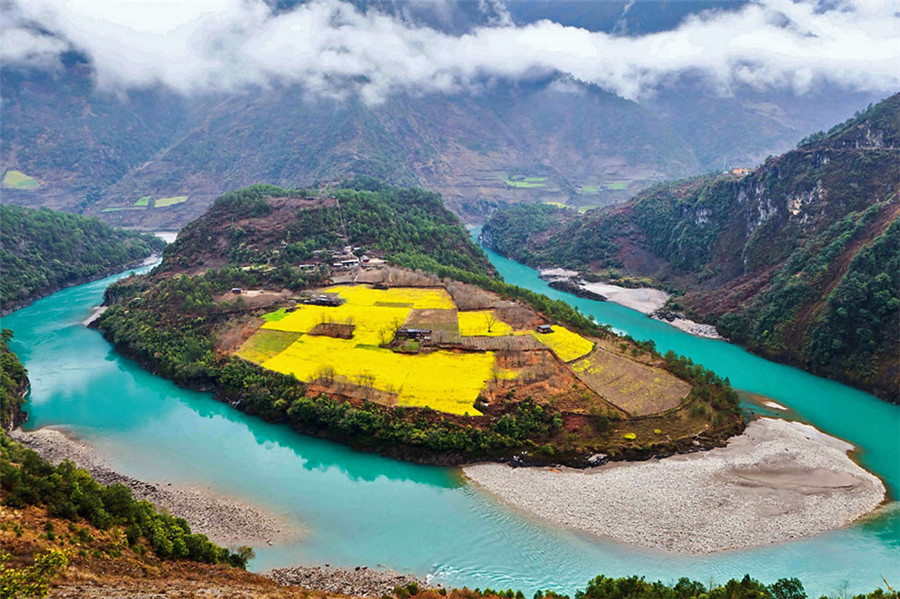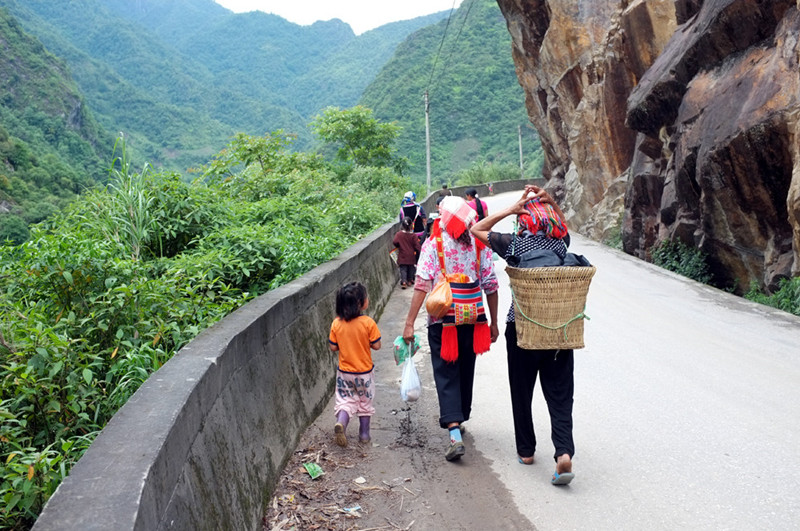
Nujiang Overview
Nujiang Overview will give you a comprehensive understanding of Nuijiang Lisu Autonomous Prefecture including the basic information, geographical location, climate and so on. Located in West of Yunnan, Nujiang Lisu Autonomous Prefecture got its name from Nujiang River that flows through from north to south, which is the only autonomous prefecture of Lisu ethnic minority in China. Among all the ethnic minorities inhabited in Nujiang, Dulong nationality and Nu nationlity can be only found here. Nujiang River is one of the rivers within the Three Rivers Natural Reserve, a world heritage site listed by UNESCO, which flows into Myanmar, joins the Salween River and ends its journey at the India Ocean.
Basic Information
- Chinese Name: 怒江傈僳族自治州
- Area: 14703 square kilometers
- Population: 534,300
- Zip code:673200
- Dialing code: (+86) 0886
- Location: Western Frontier of Yunnan Province
- Administrative Category: Autonomous Prefecture
- Seat of Government: Liuku Town of Lushui City
- Main Ethnic Groups: Lisu, Bai, Pumi, Naxi, Dulong, Tibetan, Yi, Jingpo, Nu, Dai, Han, etc.
- Important Festival and Activities: Daogan Festival, Kuoshi Festival, Kaquewa Festival
- Famous Attractions: Nujiang Grand Canyon, The First Bend of Nujiang River, Bingzhongluo Scenic Area, Three Parallel Rivers Natural Reserve
Geography
Nujiang Lisu Autonomous Prefecture is located in the northwest of Yunnan, between east longitude 98°09- 99°39 and north latitude 25°33 - 28°23. It is connected to Diqing Tibetan Autonomous Prefecture, Dali Bai Autonomous Prefecture, Lijiang Prefecture, Myanmar to the west, Baoshan Prefecture to the south, and Chayu County, Nyingchi City of Tibet Autonomous Region to the north. The internal border is 449.467 kilometers long. Nujiang Prefecture has a maximum longitudinal distance of 320.4 kilometers from north to south, a maximum horizontal distance of 153 kilometers from east to west, and a total area of 14,703 square kilometers. Liuku Town, Lushui City, the capital of the state, is 614 kilometers away from Kunming.
Climate and Weather
Nujiang, lying in the longitudinal valley area of Hengduan Mountains in western Yunnan, enjoys a plateau monsoon climate at low latitude. Nujiang features clear dry and wet seasons, great temperature difference between day and night and small temperature difference during the whole year. The average temperature is 16.8℃-20.1℃. Due to the landform and latitude, it is colder in its northern part, warmer in the middle and hot in the south; it is cold in the high mountain area, warm in halfway up the mountain and hot along the Nujiang River.
Best Time to Visit Nujiang
Nujiang Prefecture enjoys a subtropical mountain monsoon climate with the characteristics of three-dimensional climate. Nujiang is suitable for touring in all seasons. However, it is hot and rainy in summer. Stone roads built near mountains have extremely poor road conditions, and it is hard and dangerous to walk on the roads in rainy season. Therefore, the best time to visit Nujiang should be from October to April of the next year, especially times around the Spring Festival. There are sevral ethnic festivals celebrated during the Spring Festival period. You can not only enjoy beautiful scenery, but also participate in festivals with unique local features.
Administrative Division
Nujiang administrative division gives you information about places to visit when you travel to Nujiang. Nujiang Lisu Autonomous Prefecture has jurisdiction over 1 city (Lushui City泸水市), 1 county (Fugong County福贡县 ), 2 autonomous counties(Gongshan Dulong and Nu Autonomous County贡山独龙族怒族自治县, Lanping Bai and Pumi Autonomous County兰坪白族普米族自治县). Its government is located in Liuku Town of Lushui City.
- One City: Lushui City (泸水市)
- One County: Fugong County (福贡县)
- Two Autonomous Counties : Gongshan Dulong and Nu Autonomous County (贡山独龙族怒族自治县), Lanping Bai and Pumi Autonomous County (兰坪白族普米族自治县)
History of Nujiang
Yunnan, especially the western part, is an important cultural source of ancient China, and Nujiang Prefecture was the hometown of many primitive tribes. Along with many regions in Yunnan, Nujiang was brought under the administration of the central government in the Western Han Dynasty (206BC-24AD), and was later governed by Nanzhao (738-937) and Dali (937-1253) states during the Tang and Song dynasties. Nujiang Lisu Autonomous Region was established in 1954 and changed to a prefecture three years later.
More about History of Nujiang
Nujiang Culture
Nujiang is located throughout southwest China's Yunnan Province. It’s the only autonomous prefecture of Lishu ethnic minority. There are Lishu, Nu, Dulong, Pumi, Bai, Yi, Naxi in Nujiang Lisu Autonomous Prefecture. Among them, Lishu is the dominated ethnic minority and Dulong and Nu are the indigenous ones in Nujiang. Nujiang culture boasts rich and colorful folk customs, particularly featured by the Daogan Festival of Lisu ethnic group and the Cattle-butchering custom of Dulong ethnic group. All ethnic groups have different religious beliefs. Primitive religions, Lamaism, Buddhism, Catholicism and Christianity coexist in Nujiang. During the Nujiang culture tours, tourists can experience the ethnic culture in Nujiang such as food culture, art culture and folk customs. etc. or pay a visit to traditional ethnic villages to learn more about local culture and taste authentic local food.
More about Nujiang Culture
Nujiang Transportation
Nujiang transportation is in poor condition due to its geographical situations. It is not very convenient to get to Nujiang. Outer transporation of Nujiang prefecture mainly relies on long-distance buses. Up to date, there aren't airlines and trains available in Nujiang. Traffic in Nujiang is not very convenient, without train and plane. Here are some transfer modes for you to plan an easier travel. There are several ways to go to Nujiang: 1. Kunming bus to Nujiang (Liuku or Gongshan); 2. Kunming-Baoshan-Liuku (Kunming-Baoshan by air); 3. Kunming-Dali-Liuku (Kunming-Dali by air).
More about Nujiang Transportation
Things to Do in Nujiang
Nujiang travel features in adventure trip to Grand Canyon, the unique and magnificent natural landscape and colorful ethnic culture experience. We provide wide range of featured Nujiang tours such as hiking or rafting along the Grand Canyon, birding tours and ethnic culture tours, etc. Moreover, you can also try the activities recommended in Nujiang Entertainment, like joining festival party, watching the performance "Canyon Nujiang" or relaxing in the farmyards.
Nujiang Economy
In 2016, Nujiang GDP reached 12.646 billion yuan, up 10.5% over the previous year, 3.8 percentage points higher than the national 6.7% and 1.8 percentage points higher than the province's 8.7%. Wherein, the added value of the primary industry reached 2 billion yuan, up 5.2% over the previous year, contributing 8.25% to the GDP growth, driving the GDP growth in Nujiang by 0.87 percentage points. The added value of the secondary industry was 3.787 billion yuan, up 12.9% over the previous year, contributing 37.27% to the GDP growth, driving the GDP growth in Nujiang by 3.91 percentage points. The added value of industrial line was 2.221 billion yuan, up 8.9% over the previous year, contributing 15.94% to the GDP growth, driving the GDP growth of Nujiang by 1.67 percentage points. The added value of the tertiary industry was 6.859 billion yuan, up 10.8% over the previous year, contributing 54.48% to the GDP growth, driving the GDP growth by 5.72 percentage points. The proportion of three industries in Nujiang is 15.82: 29.95: 54.24. The non-public economy is booming, creating an added value of 5.088 billion yuan, an increase of 10.6% over the previous year at comparable prices, accounting for 40.2% of the GDP. Per capita GDP based on the resident population increased from 20,950 yuan last year to 23,289 yuan, an increase of 9.9% over the previous year.
Natural Resources in Nujiang
Plant Resources
Nujiang Prefecture belongs to the Himalayan plant region of China, where the Pan-Arctic plant region and the ancient tropical plant region meet. It has become one of the regions with the most abundant combination of regional plant types. It is a natural plant gene pool and has long attracted the attention of botanists at home and abroad. There are more than 200 families, 600 genera and 3,000 species of higher plants known in Nujiang. Nujiang Prefecture has 649,000 hectares of forest land, with a forest coverage rate of 70%.
Animal Resources
According to investigations made by Kunming Institute of Zoology, Chinese Academy of Sciences, 488 species of vertebrates are known, including more than 40 species of national protected animals and 284 species of birds (32 species of birds are Sino-Japanese protected migratory birds and 8 species are endangered birds in the world). There are 128 species of mammals, 30 species of reptiles, 30 species of amphibians and 44 species of fishes. In order to better protect animal resources, Nujiang governement has designated the region of Gaoligong Mountain adjacent to Lushui County and Baoshan City, and the area above 3,000 meters above sea level of Biluo Snow Mountain in Lushui County, Fugong County and Gongshan County as national nature reserves, with a total area of 323,000 hectares, accounting for 43.9% of the total area of Yunnan Province's national nature reserves and 22% of Nujiang Prefecture's land area. There are more than 1,500 species of animals and plants under protection.
Water Resources
Nujiang Prefecture boasts rich water resources, with three main rivers including Nujiang River, Lancang River and Dulong River and 183 tributaries running through the region. The total amount of water resources is 95.591 billion cubic meters, accounting for 43% of the total amount of water resources in Yunnan Province. Nujiang River, Lancang River, Dulongjiang River and its tributaries have large drop, fast flow rate and extremely rich hydropower resources. The theoretical hydropower resources in Nujiang Prefecture amount to more than 20 million kilowatts, accounting for 20% of the hydropower resources in Yunnan Province. The exploitable installed capacity is 18 million kilowatts, and the annual power generation can reach 85.09 billion kilowatts, accounting for 19% of Yunnan Province.
Land Resources
Nujiang prefecture has a land area of 14,703 square kilometers and the cultivated area is 50,569 hectares. There are 968 mu of forest land. Other forestry land covers 597 mu and grazing land covers 598 million mu. Statistics on the prefecture's three major land resources of agriculture, forestry and animal husbandry show that 18.95 million mu of land is available, accounting for 84.3% of the total land area. The water area is 152,890 mu, accounting for 0.7% of the land area, and the beach area is 2070 mu, accounting for 0.01% of the land area.
Regional Overviews
- Lushui City Overview
- Gongshan County Overview
- Bingzhongluo Overview
- Fugong County Overview
- Lanping County Overview
- Dulongjiang Overview
Keep Reading

 7 Days GolfingTour
7 Days GolfingTour
 8 Days Group Tour
8 Days Group Tour
 8 Days Yunnan Tour
8 Days Yunnan Tour
 7 Days Shangri La Hiking
7 Days Shangri La Hiking
 11 Days Yunnan Tour
11 Days Yunnan Tour
 6 Days Yuanyang Terraces
6 Days Yuanyang Terraces
 11 Days Yunnan Tour
11 Days Yunnan Tour
 8 Days South Yunnan
8 Days South Yunnan
 7 Days Tea Tour
7 Days Tea Tour
 8 Days Muslim Tour
8 Days Muslim Tour
 12 Days Self-Driving
12 Days Self-Driving
 4 Days Haba Climbing
4 Days Haba Climbing
 Tiger Leaping Gorge
Tiger Leaping Gorge
 Stone Forest
Stone Forest
 Yunnan-Tibet
Yunnan-Tibet
 Hani Rice Terraces
Hani Rice Terraces
 Kunming
Kunming
 Lijiang
Lijiang
 Shangri-la
Shangri-la
 Dali
Dali
 XishuangBanna
XishuangBanna
 Honghe
Honghe
 Kunming
Kunming
 Lijiang
Lijiang
 Shangri-la
Shangri-la
 Yuanyang Rice Terraces
Yuanyang Rice Terraces
 Nujiang
Nujiang
 XishuangBanna
XishuangBanna
 Spring City Golf
Spring City Golf
 Snow Mountain Golf
Snow Mountain Golf
 Stone Mountain Golf
Stone Mountain Golf









